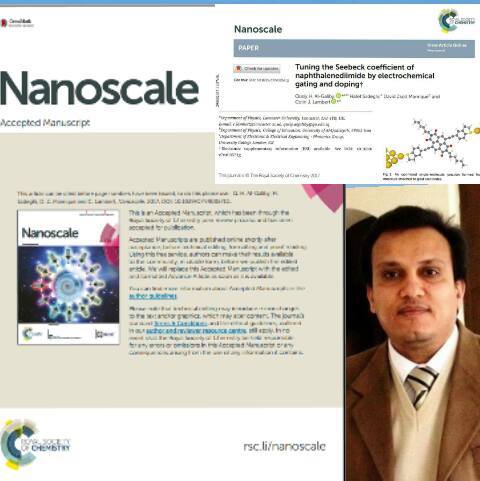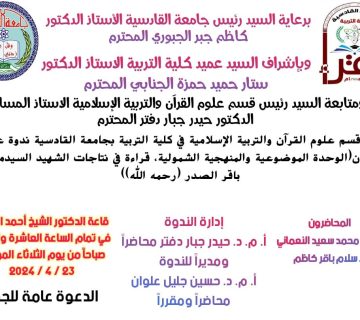التدريسي في قسم الفيزياء-كلية التربية- جامعة القادسية
بحثه الموسوم( ضبط معامل القدرة الحرارية Seebeck(SS) لجزيية النفثالين دايميد بأستخدام التبويب الكهروكيميائي والتشويب
البحث قد تم نشره في مجلة ال Nanoscale احدى منشورات مجموعة ال
Royal Society of Chemistry RSC البريطانية ذات معامل التأثير العالي وهي مجلة مصنفة ضمن ثومسن رويترزمما يفتح المجال إلى أن مثل هذه الجزيئات النشطة ذات الأكسدة هي مواد جذابة في مجال تكنولوجيا الاجهزة الكهروحرارية ذات الاغشية الرقيقة جداً
وقد اعتمد فيها اسم قسم الفيزياء /كلية التربية / جامعة القادسية كأحد المؤسسات البحثية بالتعاون مع قسم الفيزياء/جامعة لانكاستر / المملكة المتحدة وقسم الالكترونيات وهندسة الكهرباء في كلية لندن الجامعية-المملكة المتحدة
مبارك لدكتور قصي هذا الانجاز العلمي المميز ومبارك لقسم الفيزياء ولكليتنا المعطاء وجامعتنا الغراء ومزيدا من التألق والعطاء خدمة لعراقنا الحبيب عراق العلماء
Tuning the Seebeck coefficient of naphthalenediimide by electrochemical gating and doping.
We investigate the sign and magnitude of the single-molecule Seebeck coefficient of naphthalenediimide (NDI) under the influence of electrochemical gating and doping. The molecule consists of a NDI core with two alkyl chains in the bay-area position, connected to gold electrodes via benzothiophene (DBT) anchor groups. By switching between the neutral, radical and di-anion charge states, we are able to tune the molecular energy levels relative to the Fermi energy of the electrodes. The resulting single-molecule room-temperature Seebeck coefficents of the three charge states are -294.5 µv/K, 122 µv/K and 144 µv/K respectively and the room-temperature power factors are 4.4×10-5 W/m.K2 , 3×10-5 W/m.K2 and 8.2×10-4 W/m.K2. As a further strategy for optimising thermoelectric properties, we also investigate the effect on both phonon and electron transport of doping the NDI with either an electron donor (TTF) or an electron acceptor (TCNE). We find that doping by TTF increases the room-temperature Seebeck coefficient and power factor from -73.7 µv/K and 2.6×10-7 W/m.K2 for bare NDI to -105 µv/K and 3.6×10-4 W/m.K2 in presence of TTF. The low thermal conductance of NDI-TTF, combined with the higher Seebeck coefficient and higher electrical conductance lead to a maximum thermoelectric figure of merit of ZT = 1.2, which is higher than that of bare NDI in several orders of magnitude. This demonstrates that both the sign and magnitude of NDI Seebeck coefficient can be tuned reversibly by electrochemical gating and doping, suggesting that such redox active molecules are attractive materials for ultra-thin-film thermoelectric devices.
http://pubs.rsc.org/en/content/articlelanding/2017/nr/c7nr00571g#!divAbstract





لا تعليق